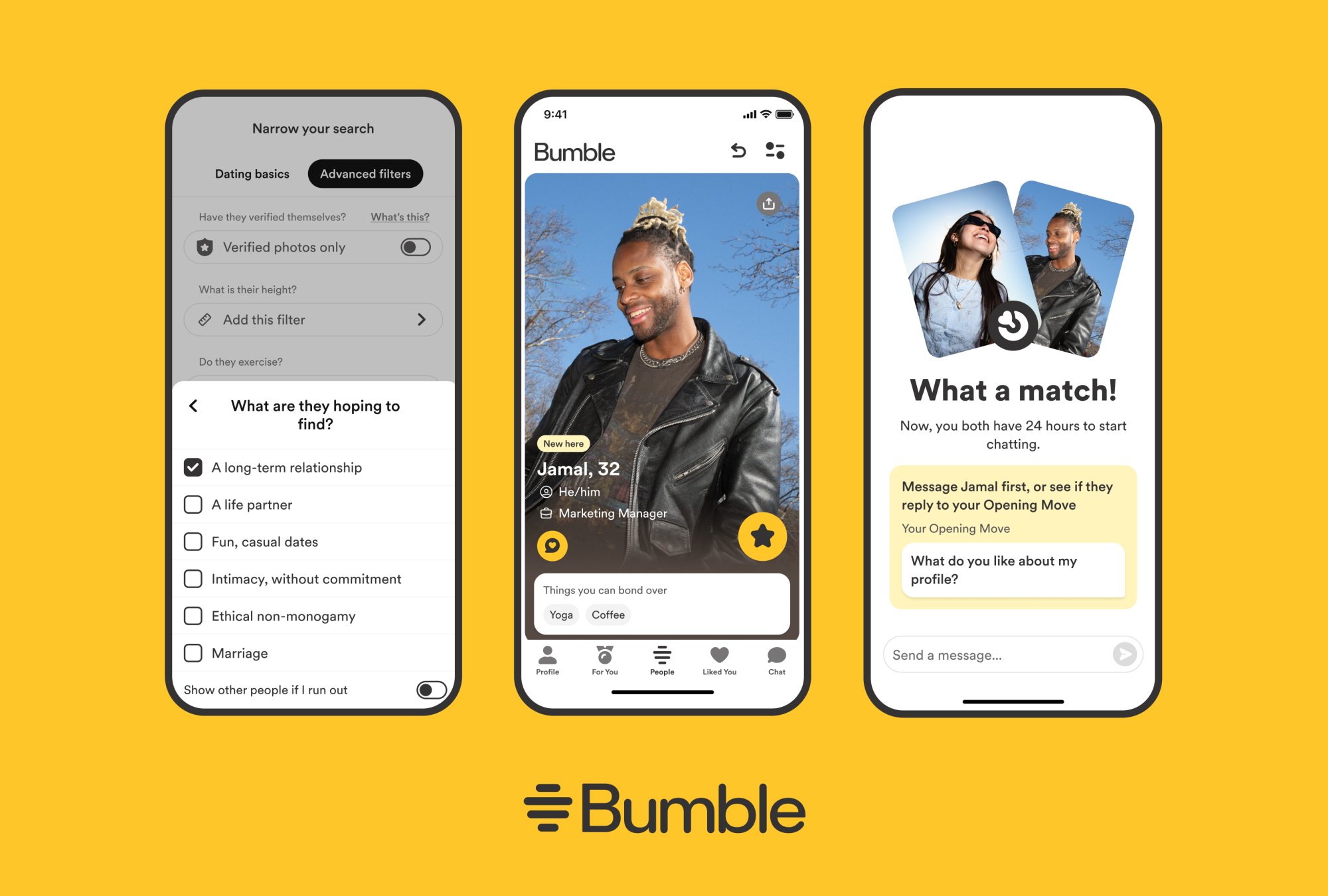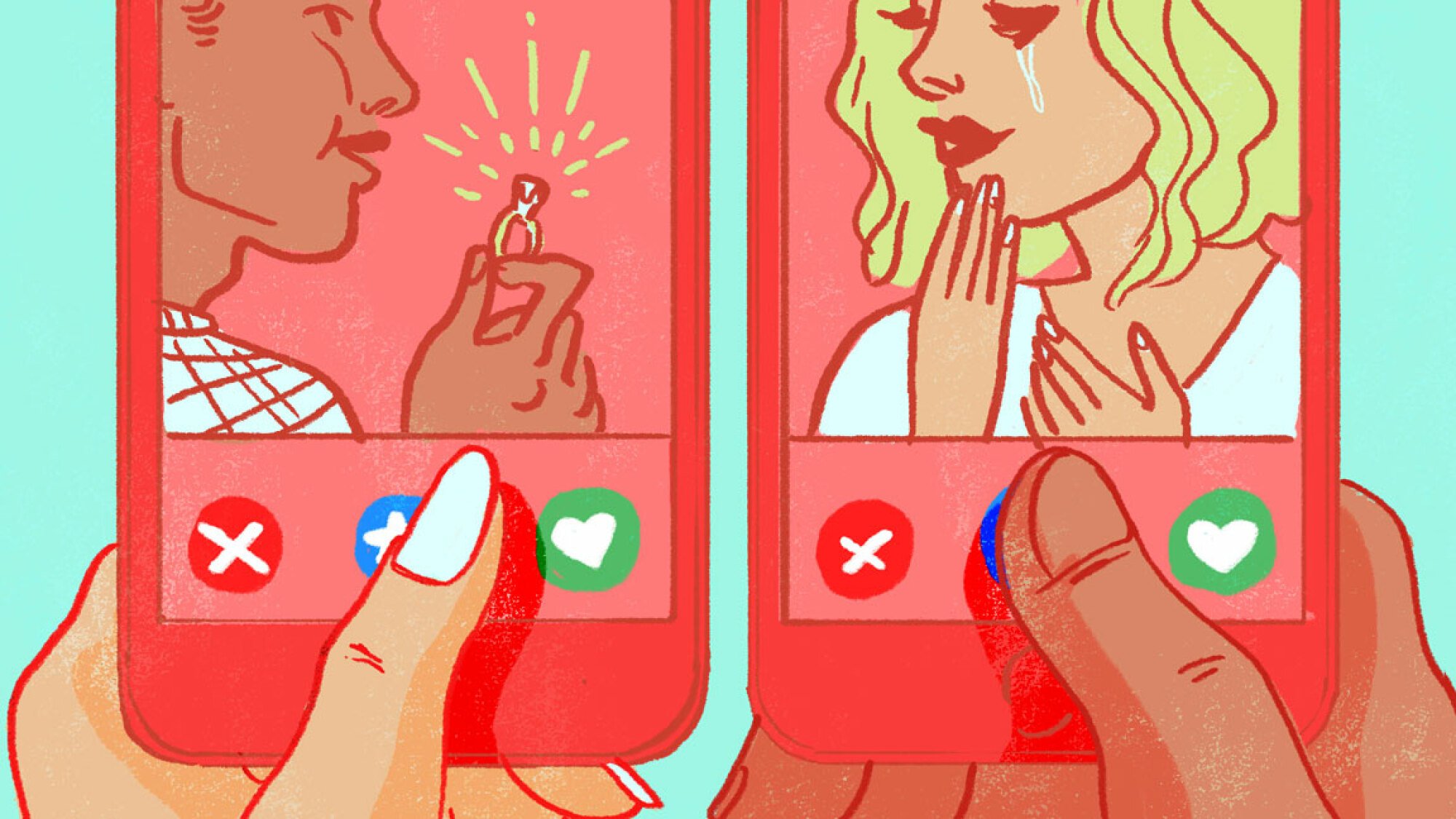How to use Bumble, and is it better than Tinder?

Despite many new additions to the dating app landscape, Bumble continues to be one of the most popular apps with 58 million users in 2023, according to Business of Apps. The app remains in close competition with Tinder as a “top” dating app. But what is Bumble — and is it better than Tinder?
What is Bumble?
Bumble is a dating app created in 2014 by Whitney Wolfe Herd. Wolfe Herd was CEO of Bumble until the start of 2024, when she stepped down (though remains as executive chair) and Lidiane Jones became CEO.
Since its start, Bumble has been known for “women making the first move.” For users seeking heterosexual connections, only women users could message male matches first. These users had 24 hours from the time they matched to send a message, and the match then had another 24 hours to reply — or else the match disappeared. For same-sex connections, anyone could message first. In the case of nonbinary users, Bumble allowed them to message first since 2022.
In a March 2024 interview with Fortune, new Bumble CEO Lidiane Jones hinted that Bumble was rethinking “women making the first move” due to dating app fatigue. By the end of April, Bumble announced changes to its app including the “first move.”
A new Bumble feature is “Opening Moves,” a prompt question women (and users seeking same-sex connections) can set so a match can technically message them first. Other additions Bumble recently made include expanding Dating Intentions and the amount of photos users must have on their profile (four as opposed to two).
Creating a Bumble account
To create an account on Bumble, sign up with your Facebook account, Apple ID, or your phone number. From there, the app will prompt you to create your profile. You’ll type in your name, add your birthday and your gender, and what gender matches you’re looking for: men, women, nonbinary people, or some combination of the three.
Bumble will then ask for your Dating Intentions. Since the recent update, the options are:
A long-term relationship
A life partner
Fun, casual dates
Intimacy, without commitment
Ethical non-monogamy
Marriage
You can select up to two, or skip this.
From there, add your interests — hobbies and activities you enjoy. You can also add qualities and traits you value (i.e. ambition and empathy) and causes you care about (i.e. feminism and trans rights).
Bumble has also updated prompts to engender conversation, like “I’m known for…” and “I’m a real nerd about…”
Bumble now mandates users upload four photos of themselves on the app. Afterwards, users must accept a “kindness pledge,” promising to be respectful. Over the years, Bumble has cracked down on “bad behavior” like cyberbullying and flaking. The app has also added an AI-powered tool to weed out scam profiles.

Bumble Premium and Bumble Boost
You can use Bumble for free, but the app also has two paid options: Bumble Premium and Bumble Boost.
Here are the prices listed for Bumble Premium subscriptions as of 2024:
1 week at $ 27.99
1 month at $ 54.99
3 months at $ 109.99
Alternatively, there’s Bumble Boost, which is cheaper. Prices are:
1 week at $ 14.99
1 month at $ 29.99
3 months at $ 49.99
With Bumble Boost, users can backtrack (reverse a left swipe); extend time on matches for an additional 24 hours; receive unlimited swipes, one Spotlight per week (putting your profile at the top of the swiping “stack”), and five SuperSwipes a week (letting a potential match know beforehand that you want to match).
Premium members receive all those perks, plus unlimited Advanced Filters; the ability to rematch with expired matches; Travel Mode (swipe anywhere you want to); and seeing everyone who’s already liked you (aka your Beeline); and Incognito Mode.
How many likes do you get on Bumble?
After completing your profile and preferences, it’s time to swipe. Bumble is similar to Tinder: swipe left to dislike, right to like. Scroll down to view more of a viewer’s profile. Bumble doesn’t give a specific number of swipes free accounts have per day, but if the app notices you’re on a frenzy, they’ll limit your swipes.
When do you get more likes on Bumble?
Once Bumble restricts your swipes, you’ll be able to swipe again after 24 hours.
How does Bumble work?
If you’re a woman, you have 24 hours to respond to a match, or else it disappears — barring your one extension per day on a free account or your match replying to your Opening Move. Once you message, it’s in your match’s hands. If they don’t message back within 24 hours, the match expires too. Should both of you message, the match won’t go away unless you manually report or unmatch the other person.
If you’re a man looking for other men, you can set an Opening Move.
You don’t have to use Bumble to date (“Bumble Date”), however. There’s Bumble BFF, for those looking for platonic relationships, and Bumble Bizz, a networking offshoot. The UX is similar, where you swipe to match with users. Users can only choose one setting at a time, though.
Is Bumble better than Tinder?
Given Tinder’s less than stellar reputation, one may ask whether Bumble is the better option. Their interface is similar, so if you don’t like swiping, neither Tinder nor Bumble is the dating app for you.
If you don’t mind swiping, and you’re into Bumble’s “first move” or Opening Move ethos, give it a shot. The app’s 24-hour rule on both sides, however, can be daunting. Sometimes you may not be in the mood to chat right away, or you may be swiping during a work break and forget to check back in. Tinder doesn’t have time restraints.
Tinder also doesn’t have alternative services like Bumble BFF or Bizz. If you’re already in a relationship but looking for a different kind of connection, Bumble is your best bet.
There’s also chatter about the “types” of people you’d find Tinder versus Bumble, like that users on the latter are more serious than those on the former. Given that Tinder has resulted in long-term relationships and marriages — and so has Bumble — I don’t take stock in those assumptions. These days, people are on all types of dating apps for all different reasons; the specific app may not matter.

What are the pros and cons to Bumble?
Pros:
Bumble is free to use (but some features — like seeing who already liked you — are only available for Premium users)
Women message first or set an Opening Move
Matches must match each other within 24 hours — a pro if you want to avoid flakes
Bumble has fun prompts to answer to get to know your match better
Bumble BFF and Bumble Bizz make it possible to either make friends or add to your professional network
Cons:
Some features, like Incognito Mode and Advanced Filters, are for paid users only
Matches disappear if both people don’t message within 24 hours, unless free members use their one extension/day or members have Boost or Premium accounts
Some users may not like the new Opening Moves feature, as men can now message first
You can only use one mode of Bumble (Date, BFF, or Bizz) at a time
How does Bumble work for guys? What about LGBTQ people?
For straight people, women message first unless they set an Opening Move. In that case, men can message first.
If you’re looking for same-sex connections, either match can set an Opening Move or message first. If you’re nonbinary, you can message first on Bumble.
Bumble is a popular dating app that, like any, has its advantages and disadvantages. The only way to see if the “buzz” is worth it is to try it out for yourself.
This article was originally published in 2021 and updated in 2024.


